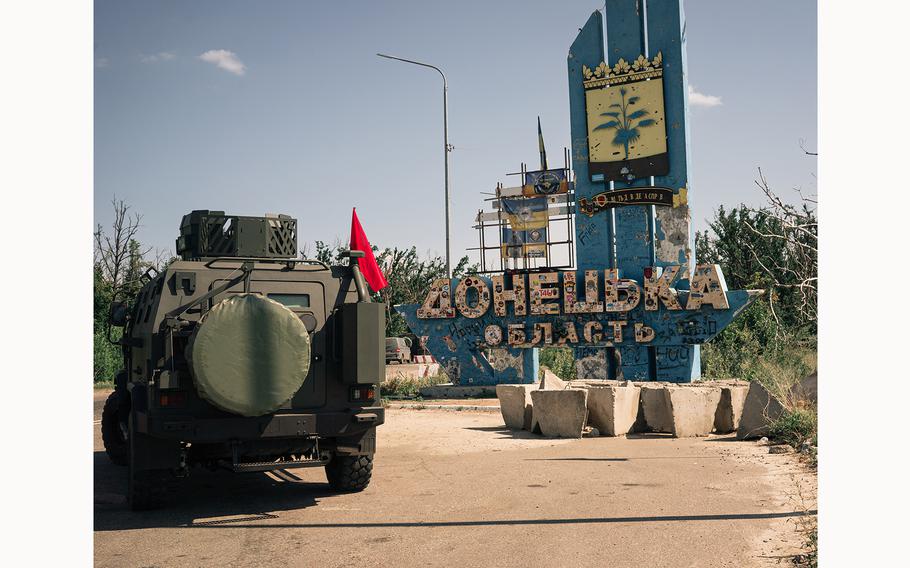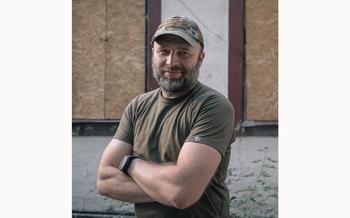Europe
Russia, adapting tactics, advances in Donetsk and takes more Ukrainian land
The Washington Post July 27, 2024

A Ukrainian armored vehicle parked by a sign marking an entrance to the Donetsk region in eastern Ukraine. (Alice Martins for The Washington Post)
POKROVSK, Ukraine — Russian forces have mounted an arc of attack in Ukraine’s eastern Donbas region, pushing through intense summer heat in a bid to extend Moscow’s steady territorial gains and capture the city of Pokrovsk, a key transit junction.
The offensive is underway as Ukraine continues to suffer from a shortage of soldiers and as election turmoil in the United States has set off new speculation that Kyiv may soon be forced to negotiate a surrender of lands.
After an influx of American weapons and money helped Ukraine blunt a renewed invasion of the northeast Kharkiv region in May, preventing a major breakthrough and dashing Moscow’s hopes of surrounding Ukraine’s second-largest city, Russian commanders have refocused their attention on the Donetsk region, perhaps Russian President Vladimir Putin’s top territorial goal.
The reinvasion of the Kharkiv region, while yielding limited gains, nonetheless diverted Ukrainian resources. Oleksandr, 30, a battalion commander of the 47th brigade, fighting near Ocheretyne, said that Ukrainian forces are struggling and that Putin’s prize increasingly seems within Russia’s reach.
“This strategy is clever: You try to concentrate the strength of your enemy in one direction and then distract them at another,” said Oleksandr, whose call sign is “Genius” and who is being identified only by first name in keeping with Ukrainian military protocol.

Oleksandr, 30, who goes by the call sign “Genius,” is the commander of a battalion in the 47th brigade fighting in the Donetsk region. (Alice Martins for The Washington Post)
“Their first objective is to destroy us,” he said. “The second is to push us so that they can get more leverage for peace talks and get more from us. They are almost at the point of capturing the Donetsk region.”
Putin’s troops are now pressing along an arc of three key points: Chasiv Yar, just west of the city of Bakhmut, which Russia captured in spring 2023; the small industrial city of Toretsk; and in rural terrain west of Ocheretyne, a village on strategic high ground seized in May after Russian forces advanced northwest from Avdiivka, which they occupied in February.
While there is intense fighting elsewhere, including in Kupyansk in the northeast and on some spots along the southern front, the offensive in Donetsk represents a notable shift in tactics by Russian commanders who appear to have learned from past mistakes and are now achieving steady gains for the Kremlin, also threatening the Ukrainian city of Kostiantynivka, which sits on a strategic highway.
This week, the Institute for the Study of War, a Washington-based think tank, reported that Ukraine halted a large mechanized assault by Russian forces near Kostiantynivka, resulting in a significant loss of Russian equipment. On Friday, Ukraine’s General Staff reported that the “hottest situation” remained near Pokrovsk.
“This new push in the Donetsk region is very interesting as it indicates that there is wider operational planning change,” said Karolina Hird, an analyst at ISW. “Meaningful advance was previously inhibited by Russian tactical blunders and they’ve struggled to strategize in the last few years.”
“Having previously just thrown men at prolonged, high casualty efforts,” she continued, “Russian operational commanders are now learning how to do simultaneous and mutual reinforcing offensive efforts and maintain constant pressure on Ukrainian resources.”
Ukraine’s depleted forces are feeling the pressure, worsened by the sweltering summer heat, with temperatures spiking earlier this month to more than 104 degrees in some areas of the front.
Ukrainian commanders and soldiers interviewed by The Post cited exhaustion and dwindling resources, including a severe lack of troops. A new mobilization law adopted by Ukraine’s parliament has yet to provide desperately needed reinforcements, as new conscripts are still undergoing training, and some draft-eligible men have fled the country or are hiding at home to avoid conscription.
One sergeant, 56, who goes by the call sign “Bart,” described the situation as “critical” and said there was “serious chaos” on the front lines. He blamed failures in leadership decisions, including cases of Ukrainian and Russian forces mixing up their positions.

Mikhail, 46, who goes by the call sign “Brain,” is a commander of a mortar battery fighting in the Donetsk region. (Alice Martins for The Washington Post)
Mikhail, 46, the commander of a mortar battery fighting in Krasnogorivka, who goes by the call sign “Brain,” said that reconnaissance had shown that Russia recently “raised the bar” around Ocheretyne and committed significant resources, including more troops and tanks.
Last week, Russian forces managed to advance four miles west from Ocheretyne, forcing the retreat of a Ukrainian infantry brigade holding the line in the village of Prohres.
Ukraine’s 47th Mechanized Brigade was forced into a “chaotic retreat” due to a lack of soldiers.
Some of the most intense fighting of the summer is now underway around the industrial city of Toretsk, where Russia has made significant tactical gains.
Commanders and military analysts said the purpose of that fighting, and Russian assaults on the nearby city of Niu-York, was to put pressure on Ukraine’s fatigued infantry units, with the aim of breaking through to Kostiantynivka.
Ukrainian soldiers said the Russian forces near Toretsk appeared to be using the same strategy used to capture Avdiivka in February after months of heavy fighting. There, the Russians enveloped the Ukrainians from three sides, while simultaneously exhausting them by relentlessly dropping glide bombs from above.
Now, in addition to incessant bombing and drone attacks, extreme heat is depleting soldiers living in trenches in Ukraine’s forests and wide-open fields. And clear blue skies mean that soldiers are even more exposed to reconnaissance and attack drones.
Some Russian forces are also moving west and north through the town of Kurakhove. If they capture Toretsk, Pokrovsk and Kostiantynivka, the entire Donetsk region would be in peril.
Several Ukrainian commanders cited an acceleration in drone warfare as one of the principal challenges on the battlefield, with Russia having significantly increased its electronic jamming capabilities to erase Ukraine’s previous advantage using first-person view, or FPV, drones.
“What has changed tremendously is their drone tactics and their use of electronic warfare. We used to have the upper hand and were more efficient, but now this is not the case,” Mikhail said.

Serhii, 29, who goes by the call sign “Shelby,” is the commander of a drone unit operating in the Donetsk region. (Alice Martins for The Washington Post)
Serhii, 29, the commander of a drone unit working in Niu-York, who goes by the call sign “Shelby,” said that Ukraine is also re-engineering drones to carry out demining and new kinds of assaults. For example, he said, engineers had attached antitank mines to heavy duty Kazhan drones.
Many vehicles in Donbas are now fitted with antennas, indicating they carry drone-jamming equipment. Soldiers also use small black boxes known as “sugars,” radars that identify and warn of circling drones. Sugars didn’t exist in Ukraine a year ago but are now common.
Ukrainian soldiers also noted an increase in the use of aviation bombs, especially Soviet-era glide bombs, around Chasiv Yar and Niu-York, which they said was causing significant damage and affecting morale. Some weigh 6,600 pounds and can destroy infantry positions and buildings with catastrophic effect.
Eugene, 41, a drone pilot working in Niu-York, said that while Russian commanders were still relying on “meat assault” tactics - sending waves of often underprepared, recent conscripts at a target - they also are applying new “scorched earth” tactics to obliterate entire towns.
“The Russians are hitting Niu-York with aviation bombs and artillery to completely obliterate entire quadrants of the city so that they can move troops in,” Serhii, the drone commander, said.

Pasha, 34, is the commander of a drone unit operating in the Donetsk region. (Alice Martins for The Washington Post)
Pasha, 34, a drone commander fighting with the 105th brigade, described the situation in Niu-York as “really hard.”
“They are using Niu-York to encircle Toretsk - and I think they have a real chance now of encircling it, it’s just a question of resources and timing,” Pasha said. The glide bombs are so powerful, they can incapacitate entire infantry units with concussions, he said.
Hird, of the Institute for the Study of War, said that Russia was unlikely to succeed despite its recent gains.
“Russia has not demonstrated that it can effectively perform mechanized advances and take large swaths of territory, so it is unlikely they’d be able to take the whole of Donbas by force,” she said. Still, she said, a slow, grinding, attritional conflict was more beneficial to Moscow as Ukrainian morale flags and future Western support is called into doubt.
Siobhán O’Grady in Kyiv contributed to this report.